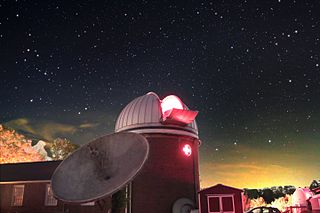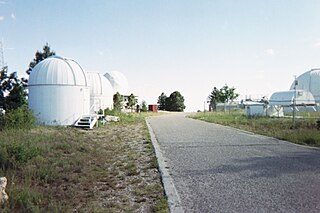Related Research Articles

Yerkes Observatory is an astronomical observatory located in Williams Bay, Wisconsin, United States. The observatory was operated by the University of Chicago Department of Astronomy and Astrophysics from its founding in 1897 to 2018. Ownership was transferred to the non-profit Yerkes Future Foundation (YFF) in May 2020, which began restoration and renovation of the historic building and grounds. Re-opening for public tours and programming began May 27, 2022.

The Lick Observatory is an astronomical observatory owned and operated by the University of California. It is on the summit of Mount Hamilton, in the Diablo Range just east of San Jose, California, United States. The observatory is managed by the University of California Observatories, with headquarters on the University of California, Santa Cruz campus, where its scientific staff moved in the mid-1960s. It is named after James Lick.

The Mount Wilson Observatory (MWO) is an astronomical observatory in Los Angeles County, California, United States. The MWO is located on Mount Wilson, a 1,740-meter (5,710-foot) peak in the San Gabriel Mountains near Pasadena, northeast of Los Angeles.

The Dominion Astrophysical Observatory, located on Observatory Hill, in Saanich, British Columbia, was completed in 1918 by the Canadian government. The Dominion architect responsible for the building was Edgar Lewis Horwood. The main instrument is the 72-inch-aperture (1.83 m) Plaskett telescope, proposed and designed by John S. Plaskett in 1910 with the support of the International Union for Cooperation in Solar Research.

Andrew Ainslie Common FRS (1841–1903) was an English amateur astronomer best known for his pioneering work in astrophotography.

The Stellafane Observatory is an astronomical observatory in Springfield, Vermont, founded in 1920 by Russell W. Porter. The Pink Clubhouse was built in 1923 at the site by the Springfield Telescope Makers Club. The name Stellafane, suggested by Porter at the club's December 1923 meeting, is derived from the Latin words stella and fanum meaning "Shrine to the Stars", and originally referred specifically to the clubhouse, but has since come to refer to all of the club's land and buildings on the summit of Breezy Hill, west of downtown Springfield.

Mount Laguna Observatory (MLO) is an astronomical observatory owned and operated by San Diego State University (SDSU). The telescope was operated in partnership with the University of Illinois at Urbana-Champaign (UIUC) until 2000. MLO is located approximately 75 kilometers (47 mi) east of downtown San Diego, California (USA) on the eastern edge of the Cleveland National Forest in the Laguna Mountains on the SDSU Astronomy Campus near the hamlet of Mount Laguna. MLO was dedicated on June 19, 1968, seven years after SDSU's Department of Astronomy became an independent academic department of SDSU's College of Sciences. The dedication took place during the 1968 summer meeting of the Astronomical Society of the Pacific. Currently SDSU is working with University of Kansas (KU), and UNC Chapel Hill on various projects.
The Amateur Astronomers Association of Pittsburgh (AAAP) is an Astronomical Organization founded on June 9, 1929, by Chester B. Roe and Leo J. Scanlon. Since then, it has grown to over 500 members and operates two observatories in the Pittsburgh region: the Nicholas E. Wagman Observatory and the Mingo Creek Park Observatory. The club also sponsors many star parties which also is open to members of the public throughout the year.
Stull Observatory is an astronomical observatory owned and operated by Alfred University located in Alfred, New York (USA) and named after John Stull, who helped establish the observatory in 1966. It is notable for housing seven independently housed telescopes ranging in size from 8 to 32 inches. The largest, the Austin-Fellows 32 inch Newtonian Reflector is tied with the Vassar College Class of 1951 Observatory for the rank of second largest optical telescope in New York state after the 40 inch telescope at SUNY Oneonta College Observatory. Telescopes at the observatory are regularly opened to the public. The observatory is also used for those pursuing a minor in astronomy or a concentration in astrophysics.

Custer Observatory is an astronomical observatory owned and operated by Custer Institute. Located in Southold, New York (US), facing Peconic Bay and Shelter Island, Custer's location has some of the darkest skies on Long Island.

Mount Lemmon Observatory (MLO), also known as the Mount Lemmon Infrared Observatory, is an astronomical observatory located on Mount Lemmon in the Santa Catalina Mountains approximately 28 kilometers (17 mi) northeast of Tucson, Arizona (US). The site in the Coronado National Forest is used with special permission from the U.S. Forest Service by the University of Arizona's Steward Observatory, and contains a number of independently managed telescopes.

Melbourne Observatory is an observatory located on a hill adjacent to the Royal Botanic Gardens Victoria. The observatory commenced operations in 1862 and was decommissioned from official Government work in 1945. The observatory has since continued as an astronomical observatory and remains open to the public. Melbourne Observatory is also permanently on the Australian National Heritage List under 'Melbourne's Domain Parkland and Memorial Precinct' since early 2018.

J A Jones Hoober Observatory is a privately owned observatory located in South Yorkshire, England near to the villages of Hoober and Wentworth, 4 miles (6.4 km) North-northwest of Rotherham. It can be found about 300 metres (0.19 mi) east of Hoober Stand. The observatory is owned and operated by Mexborough & Swinton Astronomical Society (NPO).

Powell Observatory is an astronomical observatory located near Louisburg in Miami County, Kansas. It features several large telescopes and is available for public viewing, for private use of Astronomical Society of Kansas City members, and for ongoing research projects.
The Hector J. Robinson Observatory, located in Lincoln Park, Michigan, is an Astronomical Observatory that features a 14-inch Celestron SCT telescope. Following renovation, the observatory resumed operations in September 2009, with First light ceremonies taking place in early September of that same year.
The Dark Sky Observatory (DSO) is an astronomical observatory owned and operated by Appalachian State University (ASU). It is located 9 kilometers (5.6 mi) east of Deep Gap, North Carolina (USA), off of the Blue Ridge Parkway, and 32 kilometers (20 mi) east of the ASU campus in Boone, North Carolina It was established in 1981, and is used for research, instruction, and public viewing events. The Cline Visitors' Center was completed in 2011.

Catalina Station (CS), also known as Steward Observatory Catalina Station, is an astronomical observing facility located on Mount Bigelow in the Santa Catalina Mountains approximately 29 kilometers (18 mi) northeast of Tucson, Arizona. The site in the Coronado National Forest is used with special permission from the United States Forest Service by the Steward Observatory of the University of Arizona.
Sheep Hill Observatory is an Astronomical observatory located in Morris County, New Jersey. It features an 18-inch (457mm) Newtonian reflecting telescope and is open to the public on the 3rd Friday evening of each month, weather permitting. It is also made available to Schools, Scouting Groups and other educational groups upon request.
The Mount Kobau National Observatory was a proposed astronomical observatory in southern British Columbia, Canada.
The Astronomy Centre, also known as the Amateur Astronomy Centre, is an astronomical observatory located in northern England which is run by experienced amateur astronomers and is open to the public at certain times.
References
- ↑ The Monash Observatory, pamphlet
- ↑ John Innis. "A Very Short Unofficial History of the Monash University Observatory at Mt Burnett, Victoria". Archived from the original on 8 April 2011. Retrieved 14 April 2011.